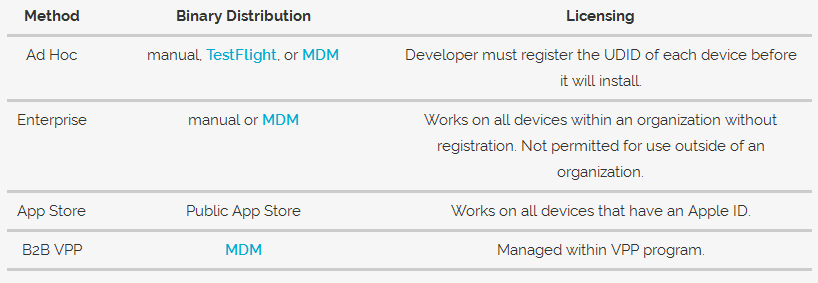How to Distribute Custom iOS Apps for Businesses?

Table of Content
Earmarked as the biggest avenue for business promotion of all scale and sizes, mobile apps are more than just a mundane piece of technology. Mobile app development has extended its horizons and have established itself as a vital part of a modern-day consumer’s lifestyle. The trajectory of the mobile app bandwagon is on its way up. Everyday thousands of smartphone apps are published on the app stores with diverse features like in-app purchase, push notifications, enterprise apps, appointment booking, chatbots, and so much more!
The only two players who stand today in the app market are Android and iOS. However, when it comes to quality and consistency, Apple or iOS clearly has an edge over Android. What truly sets Apple apart from the rest of the app stores is the extensive range of programs that can be used for deploying their custom apps for the iOS platform.
Here, in this article, we will discuss all of the possible methods of deploying apps to iOS store. So, no matter, whether you are distributing custom app within the enterprise or apps for public, the deployment of iOS apps is categorized, based on two different qualities – how the app binary is delivered to devices, and how licensing is handled.
Sorting out the Right Option
Generally, there are four different ways of app distribution, but only one way will prove to be the appropriate choice for your iOS app distribution needs. Here are listed four different ways of distributing apps on Apple App Store.
Let’s discuss each of these methods in detail –
App Store Distribution
One of the most common methods of deploying custom apps for iOS devices is Apple App Store. Distributing apps on Apple App Store is opted by many SMBs as well as individuals, but only a few of them have clear idea about everything that this reputed app store offers. For instance, you can distribute your app for free or for a fixed price, which anyone one can access with their iOS device and Apple ID. In addition, you can even monetize your app via different options, including in-app purchase, iAD network, paid subscriptions, etc.
Though, Apple App Store is user-friendly and easy to use, but going par its app approval process has always been a challenging task for many app developers across the globe. Right from submitting an app for initial review to providing feedback, many app developers have experienced a month delay in receiving feedback and making their apps live on app stores. What’s more annoying is resolving app issues and getting it re-approved from Apple. Let’s take an example, if there is any issue within your app, for instance a bug or a security vulnerability, Apple will ask you to resolve it and make the app appropriate as per their app store guidelines. Once all of the issues are resolved at your end, you need to resubmit the app on app store, and wait for their feedback, for which you need to again wait for a couple of weeks till your app is finally live on iTunes.
Though, the process of distributing custom apps on Apple App Store is troublesome, but if you need optimum visibility and availability for your app, it will surely prove to be the best choice in a long run. However, if you want to get rid of long app approval process of Apple, here are discussed a few other ways that you can implement for distributing your app on iTunes.
Ad-Hoc Deployment
If you have created an app for a private beta or small temporary distribution, Apple’s Ad-Hoc Deployment is sure to get your task done efficiently, without any hassle. Specifically for app developers, in ad-hoc deployment, developers have to deliver the app binary to each device for using email services or downloading a URL, or for any other service. But, this binary code doesn’t work on every iOS device, app developers need to add the UDID of each device, and register each one of them in the Apple Member Center to ensure the binary is easy to install on the registered devices.
For using this distribution method, app developers simply need to export the app from Xcode with the Ad-Hoc Deployment option. Once the binary is exported, you can also distribute it through MDM, similarly like enterprise binary. However, the main difference lies in managing the UDIDs for the binary, as distributing it through MDM can’t miraculously make licensing in the binary more permissive.
Apple Business Manager
Apple Business Manager or ABM is an Apple-hosted cloud portal that lets businesses manage the Device Enrolment Program (DEP), Volume Purchase Program (VPP), Apple IDs, and content from a central management point. The portal offers granular access control with admin delegation so that you can create admins who have responsibilities only for specific locations.
Entities that were using DEP or VPP can upgrade to ABM without much of a hassle using their desktops. ABM lets you automatically add Apple devices after the purchase. On turning the devices on, configurations, apps and books are installed automatically. On ABM when you buy apps and books in bulk, they can be assigned to the devices that your employees are using. These apps can then be simply reassigned to other devices if need be.
On the portal you can even create separate locations for all the offices in your organization and assign managers and configure settings for their own offices.
You can enroll as an Apple Business to buy and distribute content and automate device deployment using Apple Business Manager. Once you complete the enrolment process, the organizations or people you choose, will be able to see your app and buy it from the Content section of Apple Business Manager and then continue to distribute it seamlessly through Mobile Device Management or MDM. Also, organizations can offer redemption codes to authorized users who can then go and download the app on the App Store.
Enterprise Deployment
Initially no one ever thought about enterprise deployment, but this method of distributing apps came into limelight when enterprises got fed up of challenging processes of app store and ad-hoc deployment, wherein they need to wait for weeks for app approval or need to register all device UDIDs in the Apple Member Center, even for using apps for internal purposes.
In enterprise deployment, an app is generally signed and exported from Xcode in a specific way so that it can be easily installed on any device, without any hassle of registering device’s UDID or making the app live on app store. As this method of distributing apps got recognition, more and more businesses started employing it for using apps within their organizations. Although, enterprise deployment is far easier than app store and ad-hoc deployment, but in this deployment method, Apple takes the U-turn, and gives complete responsibility to the company for the distribution of the app within their organization.
The distribution of apps in this deployment method is quite similar to ad-hoc distribution, which can be performed through emails, or via specific URL. The enterprise deployment can also be done via Mobile Device Management (MDM) service, wherein app developers need to upload the binary and remotely send the installation request to every MDM-enrolled device, all through from a single web admin dashboard.
Truthfully, enterprise deployment is limited to organizations only who can create their own apps and share it among their staff for consumption. This form of app deployment is strictly against Apple’s program, in case if you are using enterprise-signed IPAs for app distribution outside the organization.
VPP Private Store B2B App Deployment
So far, we have discussed prominent app deployment methods implemented by app owners and organization across the globe. Now, let’s shed some light on one of the rarely used app deployment methods, VPP Private Store B2B App Deployment.
Registering in Apple VPP allows organizations to have their own private app store. No, we are not kidding! In this app distribution program, you can easily create internal app binaries and share it with any device joining the program. In addition, you can also share your app with others through VPP. What’s more surprising is the app approval process.
No, you don’t need to panic in this case. The app approval process in VPP Private Store B2B App Deployment is much more flexible, when compared to app store approval process, since the apps won’t be available for general consumption like on app store. Further, as Apple VPP is a private store, so the entire app deployment task is handled by the program itself, thus eradicating the need of manual submissions. Apple’s VPP program is basically employed with an MDM service, allowing organizations to send VPP push invitations as well as apps to devices from single administration dashboard.
Implementing any of the above discussed app deployment methods is sure to get your task done the right way, but before you finalize one of the programs and move ahead, it is correspondingly vital to pre-plan the actual distribution process of your app. There are hundreds of small details that you need to navigate appropriately, or else you might end up wasting your hard earned money.
Conclusion
Simply creating an app is not enough, you need to be clear about the path you are going to take when it comes to distributing it for your audience. It may appear to be a complicated path ahead when it comes to distributing your iOS apps, but with Appy Pie, things can become a whole lot simpler.
Not only do we create the entire app for you from scratch, but also help you get it published on the Apple App Store!
Build an app now!
Do you think we missed out on anything in the blog? Let us know what you think in the comments section. We’d love to hear from you!
Related Articles
- Switch Statements in Swift Explained
- 10 Best GitLab Integrations for Better Code Reviews
- 16 Amazing Tips to come up with Brand New Mobile App Ideas
- How to Create a Course Registration Bot in 3 Simple Steps?
- 10 Best Trello Integrations for Efficient Task Management in 2022
- Educational Apps for Kids: Do They Work?
- Why should you try a Black and White Brand Logo Identity?
- How to Create An App Like Zomato?
- How to Make an App Like DoorDash?
- Top Tips to Make A Successful Business App
Most Popular Posts
 Photoshop Alternatives: Top 10 Graphic Design Tools in 2024
Photoshop Alternatives: Top 10 Graphic Design Tools in 2024 By Deepak Kumar | July 25, 2024
 Canva vs Appy Pie Design – Which is Better?
Canva vs Appy Pie Design – Which is Better? By anupam | July 18, 2024
 Canva Alternatives: Top 15 Graphic Design Tools to Replace Canva in 2024
Canva Alternatives: Top 15 Graphic Design Tools to Replace Canva in 2024 By anupam | July 18, 2024
 Canva Review: Key Features, Pros, Cons & Pricing
Canva Review: Key Features, Pros, Cons & Pricing By anupam | July 18, 2024
 8 Best ManyChat Alternatives in 2024
8 Best ManyChat Alternatives in 2024 By Samarpit Nasa | July 12, 2024


